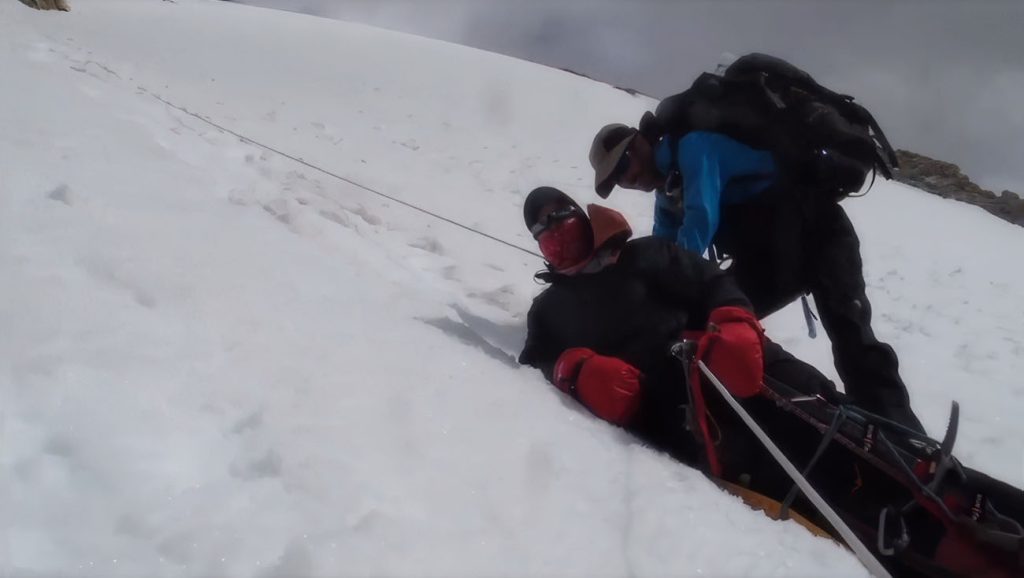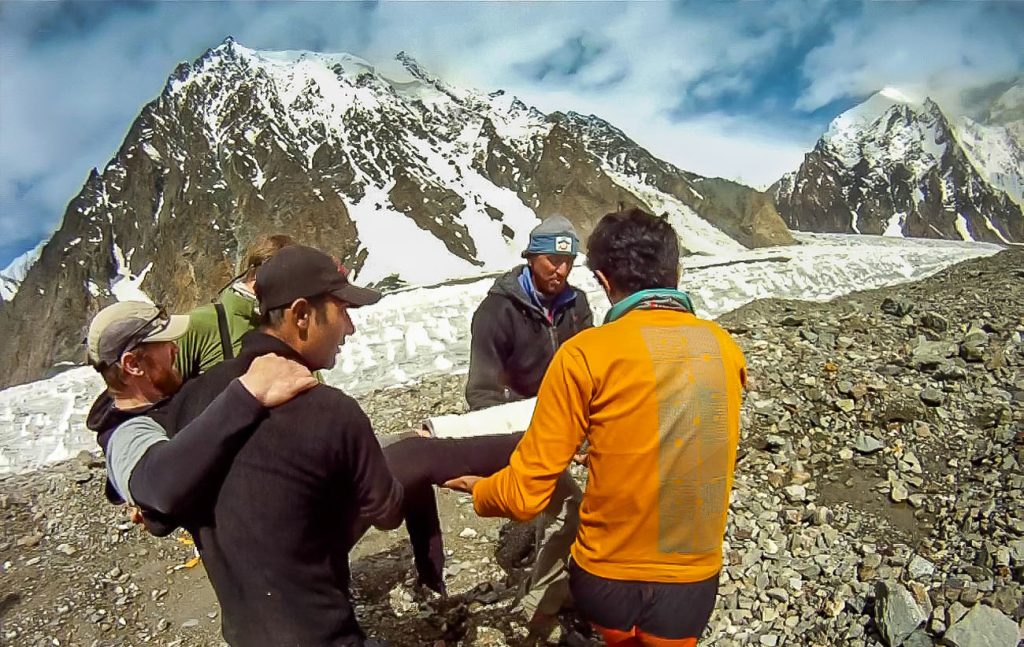I’ve had a few close calls in the mountains. But none so wild as the summer of 2013.
After a heinous spate of bad luck and weather, my climbing partner Brian Moran and I were dropping down from Camp 3 on Broad Peak in the Karakoram Mountains of Pakistan. It was a crap show from the get-go. This was not long after U.S. troops had dispatched Osama Bin Laden; the area was buzzing like a yellowjacket nest dug up by an opossum. As we inched toward this 8,000-meter peak, all manner of darkness followed us 60 miles up the glacier, ranging from severe dysentery to a random attack by errant mules. Then we found out what happened on Nanga Parbat and everything changed. The Taliban rounded up every climber they could corral on that mountain in search of Americans. Rumor has it that one of the guys tried a karate move on his captors. When the smoke cleared from their AK-47s, 10 mountaineers lay dead.
I had a different problem on my hand, presently, though. As we dropped down on our final acclimatization run from this, the 12th-highest peak on Earth, I had hoped our mojo was changing. I was no longer stomach sick, and we had stocked all the high camps for our final push to this elusive summit. We had been in country for almost five weeks, and our team of 11 disparate international climbers were ready to put this prominence in the rearview. Rappelling down these near-vertical snow slopes, we clipped and unclipped from ropes dangling from rock outcroppings in the shadow of mighty K2.
Dropping between Camp 2 and Camp 1, I lagged behind Brian a bit dealing with anchors, attaching a figure 8 carabiner. A small dot materialized on the white snow canvas some 100 feet below me at an altitude of 21,000 feet. My partner was crumpled up in a ball and screaming for me over the wind. I barely made out his words, but rappelled to his position. My friend’s leg was shattered. Clouds rolled in from China and snuffed the waning sun.
I splinted his leg with an ice ax and clipped into the fixed rope, attaching him to a sleeping pad with webbing. The arduous process of dropping him a few feet at a time was exhausting. Brian would paddle with his arms when the snow got sticky on the gradually relenting slope. We were alone on this remote mountain, and the weather was moving in. I said a prayer for help as my energy bottomed out with the physical effort of this, the second hour.

As if on cue, from the heavens, a small figure appeared several pitches above. It was Mojtaba Jarrahi, one of our teammates. Mojtaba was a mountain rescue guy in his home country of Iran; exactly what we needed. Dividing the load, we took turns lowering Brian as I radioed base camp for more assistance. Mojtaba was the only member of our Iranian group in possession of these talents and I don’t believe in coincidences. He was our third man.
A Pakistani team relieved us at Camp 1 for the near vertical sections remaining as I rested and took my first sips of water. More time had passed than I realized as I caught my breath and allowed the adrenaline to settle. It was dark now and solitude engulfed me on this big mountain.
Crampons scraping rock made sparks in my descent as I transitioned from cliffs to the ice-fall. More than a little anxiety gripped me as I realized I would be dancing through this glacial death trap which had already claimed the life of a German woman on another team. To my great surprise and relief, a light shone in my direction. It was, I presumed, one of the Pakistani porters awaiting me. I wondered who sent him to wait for me; though wordless, he motioned me down through the dangerous labyrinth of teetering ice penitents where one wrong turn could be fatal.
My guardian angel never spoke a word, he just shined his light in the direction of the safest path for the next hour as we stepped on bamboo ladders spanning rivers of barely melted water. Eventually I caught up with the 10 porters who were lifting Brian through this final stretch into the safety of base camp. Everyone was surprised to see me stumbling alone, but I just motioned in the direction of my mysterious companion who was nowhere to be found.
It would take another week before the weather cleared to land a helicopter for Brian. His leg was getting infected; we had plenty of time to recount the whole ordeal and try to make sense of my “ghost” guide. We said goodbye to Mojtaba and our Iranian friends who took advantage of the break to make their summit push as we boarded a pair of Pakistani military helicopters. Brian reached the safety of Skardu and a rudimentary hospital. A lifetime of trouble with the leg ended his climbing career. But he went on to father a beautiful young daughter named Johal, after our first camp on the trek through the Baldor glacier. My buddy would eventually resume his duties as an international airline pilot and trade crampons for a bicycle.

Mojtaba Jarrahi ascended into history, along with Puja Kyven and Aydin Borzoi. Our little brothers pushed the Iranian Route to the summit of this mighty mountain that had caused us so much trouble. Broad Peak was not done, though. Although they reached the summit, their descent turned tragic, and all three remain permanently on the flanks of K3, as this behemoth is also known. Broad Peak enfolded these heroes permanently into her arms. One of Mojtaba’s final acts was to help save the life of another. But no one was there to save him.
My third man was an unknown figure who led me through the treachery of Broad Peak’s icy ramparts. There is zero doubt that without him, I could have ended up in worse shape than Brian. Turns out this is a common and unexplained phenomena in mountaineering and adventure tales. Ernest Shackleton was the first prominent figure to describe a “guardian” that guided his shipwrecked team to safety in the early 1900s. This “Third Man” has been credited with navigating many a lost adventurer to safety and psychologists are wont to explain it. But I don’t need a psychologist, (for that anyway). Brian and I met our guardian angels and they got us out of hell. There is little doubt to either of us that they are both in the opposite place now.
A full account of this expedition can be found in John’s book, Tempting the Throne Room: Surviving Pakistan’s Deadliest Climbing Season, 2013.

Comments are closed.